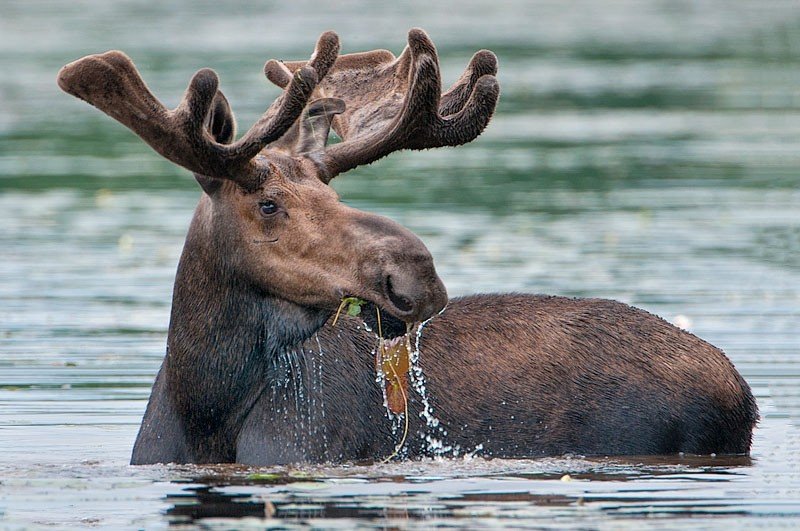
“Did you know that moose can dive as deep as five meters?” This factoid is repeated by educators across the circumpolar range of Alces alces, and often is received amazement and maybe a few chuckles from the audience as they picture the gangly, awkward moose diving to a depth about twice as deep as the bottom of an average backyard pool. But is it true? If you look at all the mammals that excel in swimming the waters of the Greater Yellowstone Ecosystem (GYE), beavers and otters stand out as the best furred swimmers. They are definitely capable of diving to the bottom of a deep pond in search of food – their webbed feet are propellers, and their thick tails are rudders. But a moose has hooves and hardly any tail to speak of. So can moose really dive five to six meters?
Here’s what we know: Moose love water. In summer, aquatic vegetation and riparian plants are the majority of their diet. They are also prone to overheating – they are stressed by summer temperatures as low as 60F, though that depends on cloud cover. The cold waters of the GYE provide a welcome, and perhaps essential, refuge from the heat of a typical summer day. Water is also a refuge in another way – with their long legs, moose will sometimes seek the safety of water to avoid predators. A moose can stand in a river where a wolf would be swept away, and they are much faster swimmers than any of our local predators. So moose are often found near water.
We also know moose are incredible swimmers, at least as hoofed animals go. They are capable of hitting speeds of at least six miles per hour. That sounds like no more than a jogging speed for humans, but most humans can only swim two miles per hour. High School swimmers hit three to four miles per hour. Olympic swimmers win medals above five miles per hour. So moose are pretty fast swimmers. They have been observed swimming long distances – over ten miles – in search of food and good habitat.
But just about any mammal can swim – including animals that you might think would instantly sink, such as pigs or armadillos. Sloths are surprisingly good swimmers and even bats can swim, albeit not gracefully. Diving is another story.
Moose have several strikes against their diving ability. They have thick fur coats with long hollow hairs to insulate them down to temperatures of -60F. This also makes moose fur tremendously buoyant. All the air molecules trapped in moose fur do what air wants to do in water – rise to the surface. So the coat of a moose acts as a lifejacket, a constant force that tugs the moose to the surface. (And if you have ever worn a life jacket on a hot sunny day without the chance to jump in the water to cool off, you know life jackets are also effective insulators!) There’s even more air in a moose’s large lungs.
What would you do if you had to dive with a lifejacket on? You’d paddle your hands and feet like mad! But moose feet are cloven hooves – well-suited to spreading their weight over mud or snow, but you wouldn’t choose a moose hoof over a flipper for diving. But despite these two handicaps, we do know moose readily and frequently submerge their bodies entirely underwater in search of food. No other member of the deer family has been observed showing this behavior.
See evidence on Youtube of moose submerging themselves and feeding here and here.
What do the experts have to say? Two of the great moose reference books mention diving in passing, but do not go into any detail. In Ecology and Management of the North American Moose (Albert W. Franzmann, Charles C. Schwartz, University of Colorado Press, 2007), the authors state “Moose readily submerge underwater to feed on aquatics and can remain underwater for up to 50 seconds. However, they sometimes have to struggle to stay down.” In Moose: Behavior, Ecology, Conservation (Valerius Geist, Voyageur Press, 1999), the author states that moose prefer shallower water but “may swim and dive for aquatic vegetation.” But there is one eye-witness account on which the oft-quoted factoids are all based. In North American Moose (Randolph L. Peterson, University of Toronto, 1995), the author reports seeing moose dive over 18 feet to feed on aquatic vegetation – though he does not mention which method he used to confirm that the moose hit that depth.
So we just don’t know for certain if moose can dive over five meters deep, though there is some anecdotal evidence that suggests they can. There’s certainly food available for them down there – aquatic plants can still grow in depths of 10-15’, depending on the water and clarity. It would be nice to prove it, but it’s sure hard to convince a moose to dive as deep as it can for a scientific study. And these short-tempered animals don’t appreciate “swim with the moose” programs so we can see for ourselves! Maybe someday, an underwater camera trap will capture a video of a moose diving deep and prove it for once and all.


